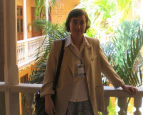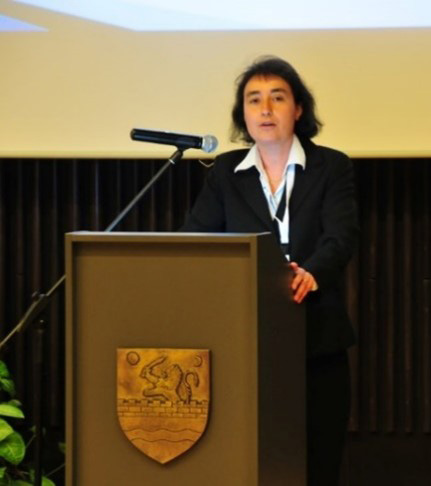I was born nearly sixty years ago in Milan. My father was a Professor of Mechanical Engineering at Politecnico di Milano. For this reason, I grew up 200 meters away from the main building of the University where I now work. My primary school was (and still is) in the same square of the Politecnico, and during my childhood, I spent my afternoons in spring riding my bike with my little friends around the campus square. If someone had told me in those days that I would have got a position at that University, I would have just laughed.
|
The campus square with the primary school on one side |

Politecnico di Milano’s main building on the other of the campus square |
My contact with the academic world started when I was a child. I liked visiting my father’s office, looking at the “grown-up students” with admiration and looking at the “magic” events that were taking place during my visits to the technical laboratories. During my primary school years, I also got in contact with the “1968 students’ revolution”. In Milan, the Politecnico’s square was, unfortunately, a place of fights between students and police. For me, the bad side of that historical moment was that I was confined at school, waiting for the situation to improve and for my parents to pick me up.

1968, in the campus square after a day at school.
When the time to choose the University course of study came, it was not easy. I had clearly in mind what I did not want to become, and instead, I had no idea of what I wanted to become. After deep reflections and a certain influence on people thinking practically, I preferred to choose a course of study with better job opportunities. My choice was Economics at Bocconi University in Milan. The doubts were so significant that made me apply on the afternoon of the deadline.
My love for Regional Economics came during my last year when I decided to attend this course. I was deeply fascinated by how space is inextricably bound up with economic activity. Regional Economics has been the only course in all my student career where I received a “cum laude” mark and decided to write my dissertation in the field of Regional Economics under the supervision of Roberto Camagni.
The day after my graduation, Roberto Camagni asked me if I wanted to help him develop some research projects while I was looking for a highly remunerative job in the private sector. I accepted, and on September 1st, 1986, I started working in the Economics Department at Bocconi University while looking for a stimulating and remunerative job in banks, insurance companies, and large firms, where I had several job interviews. I was offered several opportunities, but none was assessed to be the right one.
In 1991, a young and already famous Dutch professor, Peter Nijkamp, met me at a conference and asked me whether I would be interested in doing a PhD at the VU University in Amsterdam. Confronted with such an offer, I understood why I could not find the right job elsewhere. I had already my preferred (even if not highly remunerated) job, and the PhD was the opportunity of my life I was waiting for. In 1991 I started with enthusiasm my studies at the VU in Amsterdam. In December 1993, I received my PhD in Economics at the VU with a thesis entitled “Spatial Economic Analysis of Telecommunication Externalities”, published the following year by Avebury. The personal satisfaction I received from the dissertation and the book was unbelievable, and I still have a vivid memory of the day of the ceremony and the day the book came out.

1993, PhD defense, VU, Amsterdam.
I became an assistant professor at Politecnico of Milano two years later, and another turnaround in my life happened. Roberto Camagni left the University of Padua and joined me at the Economics department of Politecnico di Milano. At last, we were both in the same academic environment, a condition that allowed us to build a Regional Science group made of enthusiastic young scientists working with us. Since that year, the number of new and innovative research fields that I had the chance to study multiplied. I still kept my passion for regional innovation models, but I opened my mind to other fields. In my first years at Politecnico, I reinforced my empirical (econometric) expertise, fascinated by the idea of “measuring the unmeasurable”. The industrial atmosphere of the industrial districts (at that time a crucial theory of local development), the collective learning effects of the milieu innovateur theory (an evolutionary approach to the development of local production systems), network externalities of the city network theories, found quantitative proofs of their effects in my studies. In this vein, I also got fascinated by Urban Economics, revisiting all attempts made to measure the presence of agglomeration economies, innovating conceptually also by finding reasons on how to overcome the “Optimal city size theory”, demonstrating that the functions and the capacity of cities to be part of a city system rather than the size explain agglomeration economies.
In 1998, I applied to become an Associate professor. I got the position in the South of Italy, and a new adventure started. I spent three years in Campobasso (or better, travelling from and to Campobasso nearly every week), an experience that forged my physical and mental health. At the University of Molise (in Campobasso), I had to teach for the first time in my life Regional Economics; I discovered the poverty of the textbooks in Italian in that discipline. Only one textbook existed, a translation of Armstrong and Taylor’s “Regional Economics and Policy” textbook, which suffered from being out of date and lacking, for example, all the local development theories developed in recent times. After one year, I signed a contract with the publisher “Il Mulino” to write a new textbook. I still remember the three tough nights I had after signing the contract, wondering if I had asked myself too much.
I wrote my textbook during my winter and summer holidays for a few years. I read original papers of economists like the neoclassical Borts and Stein, the Keynesian North, just to mention a few of them, not to speak about the fascinating books of Walter Isard. During those readings, I discovered aspects against general beliefs, like the capacity to interpret regional divergence of the original neoclassical model of regional growth in its two regions - two sectors version. In 2004, the textbook “Economia Regionale” was at last published, and I lived another period of profound enthusiasm and deep satisfaction like the ones after the PhD and the publication of my first book. In the following years, the book was translated into English (Routledge, 2007) and Chinese (Economy and Management Publishing House, 2014), and new editions both in Italian and English followed ten years later. After writing the textbook, deduction and abstraction characterised my research projects much more than before, and I was able to produce conceptual approaches to regional innovation and regional development.
In 2003, I became a Full Professor in Regional and Urban Economics at Politecnico di Milano. Among many scientific activities I developed, I like remembering a particular one. Together with Roberto Camagni and our group, I developed the MASST model, a Macroeconomic Regional Growth model, which is now in its 5th version, thanks to Andrea Caragliu and Roberto Dellisanti. It is now known at the EU level as one of the models to build scenarios at the regional level, competing with the other few that exist - RHOMOLO, REMI, GMR – each with its specificities. Its success has been impressive and much beyond our expectations if one thinks that behind models like this one, you usually find a team of at least 15 scholars. Each MASST version has instead been produced by max 3 of us!

2005, With Roberto Camagni, ERSA Conference, Amsterdam
Being a Full Professor, I thought that the difficult and challenging times had finished and that I could go on enlarging my knowledge and enjoying my research activities with Roberto Camagni and my young colleagues. I was wrong. In 2006 I received a phone call from Peter Nijkamp telling me that he was in Milan together with Roger Stough (at that time President of RSAI) and they needed to talk to me. I invited them home for dinner, and they asked me if I would be interested in becoming the next RSAI President. I have a vivid memory of what went through my mind at that moment: at first, I thought they were joking, then that they had not clear in their mind what they were saying. To my surprise, they were extremely serious, and they knew perfectly what they were saying. After one week of insufficient sleep (like the ones after signing the contract for the textbook), I accepted. In 2007, in Vancouver, the RSAI Council elected me President of RSAI: a 45 years old woman, not entirely confident about her capacities to lead an Association of that size and complexity.

2007, National Conference of the Brazilian Association, Recife, Brazil.
Instead, two wonderful and pleasant years followed my election. I concentrated my efforts in Latin America, creating a new association in Colombia, reinforcing the just born Brazilian one and opening opportunities in Argentina (where the association was created in the following years). I re- established contacts with national associations in Europe, organised a World conference in Timisoara (Romania), and reinforced the linkage with ERSA. Finally, I modernised the rules of governance of the association, revising the constitution. But especially, I travelled all over the world, always meeting fantastic people and making new friends.

2009, Cartagena dos Indios, Colombia.

2012, RSAI World Conference, Timisoara.
As time passed, my activities enlarged to those of a member of scientific boards of research programmes, evaluation committees of research centres, President of a university course of study and Deputy Director of my Department. However, my heart is inextricably bound with scientific research. I particularly enjoy the scientific brainstorming with my young, constructive and dynamic research group that, over time, has arisen around Roberto and myself: Andrea Caragliu, Silvia Cerisola, Ugo Fratesi, Camilla Lenzi, Giovanni Perucca, Elisa Panzera and Roberto Dellisanti have developed important research fields together with Roberto and myself, with scientific rigour, creativity, competence and dedication. I hope they will have a satisfactory, full, happy, and constructive professional life like mine. I have to say that I have found the stimulating (even if not highly remunerative) job I was looking for after graduation.
(Published on RSAI Newsletter 2022 May)

